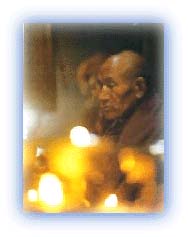Ladakh himalayas
General Info
· Villages
· Valleys and plateaus
· Lakes
· Passes
· Glaciers
· Rivers
· People
· Religion
· Fairs and festivals
· Other places of interest
· Leh
· Kargil
· Chushul
· Dras
· Zoji La Pass
· Puga Valley

![]()
| Hemis Gompa The Hemis Gompa is the biggest and the most famous Gompa of Ladakh. As one climbs up the hillside, the Gompa becomes visible and one notices that the walls are made of stone, painted white. The windows, which are fringed with colored frills for curtains on the outside, are latticed in a Tibetan design and painted in bright, simple patterns. This painting is on every piece of wood both inside and outside the structure. The gates are carved from wood, with a cutout border, and painted a canary yellow. The dome is square, painted with intricate designs from the life of Buddha, and surmounted with tops in gold leaf. |
Inside the Gompa it is dark and one's eyes take time to adjust to the shade. At the far end is an altar on which there are numerous tiny carved idols arranged in rows before a glass case containing a life size idol of the Buddha. This is carved in wood and painted gold with a background of lotus flowers.
 |
| A buddhist monk in deep thought. Credit: Discover India magazine |
A small room above the temple contains two more altars and many more carved images of the Buddha, besides all the grotesque masks and head dresses used in the war dance and the devil dance on special occasions.
The war dance is held during the "Feast of the Snowy Heights" to celebrate the spirit of the demons. These Buddhists have incorporated some of the local folklore in their religion.
All rights reserved